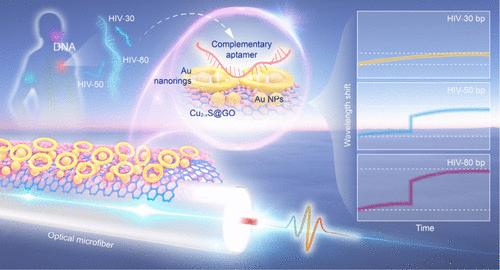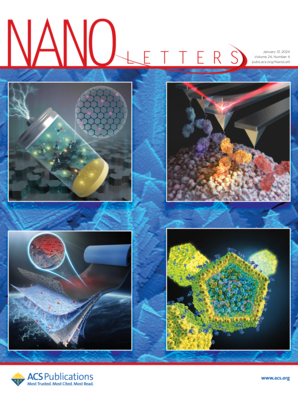Single-Molecule Amplification-Free Detection of Nucleic Acid Biomarkers from Body Fluids via an Optical Microfiber with a Nanointerface
IF 9.6
1区 材料科学
Q1 CHEMISTRY, MULTIDISCIPLINARY
引用次数: 0
Abstract
Single-molecule detection of nucleic acids in body fluids is vital but challenging. This work presents an optical microfiber biosensor with a metal–semiconductor–2D material hybrid nanointerface for single-molecule amplification-free detection of nucleic acids in complex body fluids. By optimizing the nanointerface components, we achieved significant enhancement of the evanescent field, enabling ultrahigh sensitivity at the microfiber surface. It allowed for the detection of DNA molecules at the single-molecule level and could identify single-base-pair mismatches. Utilizing a microscale diameter and millimeter-length design, the biosensor overcomes the limitations associated with nanosensors, providing a practical solution for point-of-care diagnostics. The sensor demonstrated its potential through ultrasensitive detection of HIV nucleic acids in body fluids such as serum, sweat, and saliva. This advancement marks a critical step forward in nucleic acid detection, facilitating early disease diagnosis, personalized medicine, and fundamental biological research, despite challenges posed by the nanosize, chain-like morphology, and environmental interference of nucleic acids.

利用具有纳米界面的光学微纤维检测体液中核酸生物标志物的单分子无扩增技术
体液中核酸的单分子检测至关重要,但具有挑战性。这项工作提出了一种具有金属-半导体-二维材料混合纳米界面的光学微纤维生物传感器,用于复杂体液中无单分子扩增的核酸检测。通过优化纳米界面组件,我们实现了显着增强的倏逝场,实现了超纤维表面的超高灵敏度。它允许在单分子水平上检测DNA分子,并可以识别单碱基对不匹配。利用微尺度直径和毫米长度的设计,生物传感器克服了与纳米传感器相关的局限性,为即时诊断提供了实用的解决方案。该传感器通过对血清、汗液和唾液等体液中的HIV核酸进行超灵敏检测,展示了其潜力。尽管核酸的纳米尺寸、链状形态和环境干扰带来了挑战,但这一进展标志着在核酸检测、促进疾病早期诊断、个性化医疗和基础生物学研究方面迈出了关键一步。
本文章由计算机程序翻译,如有差异,请以英文原文为准。
求助全文
约1分钟内获得全文
求助全文
来源期刊

Nano Letters
工程技术-材料科学:综合
CiteScore
16.80
自引率
2.80%
发文量
1182
审稿时长
1.4 months
期刊介绍:
Nano Letters serves as a dynamic platform for promptly disseminating original results in fundamental, applied, and emerging research across all facets of nanoscience and nanotechnology. A pivotal criterion for inclusion within Nano Letters is the convergence of at least two different areas or disciplines, ensuring a rich interdisciplinary scope. The journal is dedicated to fostering exploration in diverse areas, including:
- Experimental and theoretical findings on physical, chemical, and biological phenomena at the nanoscale
- Synthesis, characterization, and processing of organic, inorganic, polymer, and hybrid nanomaterials through physical, chemical, and biological methodologies
- Modeling and simulation of synthetic, assembly, and interaction processes
- Realization of integrated nanostructures and nano-engineered devices exhibiting advanced performance
- Applications of nanoscale materials in living and environmental systems
Nano Letters is committed to advancing and showcasing groundbreaking research that intersects various domains, fostering innovation and collaboration in the ever-evolving field of nanoscience and nanotechnology.
 求助内容:
求助内容: 应助结果提醒方式:
应助结果提醒方式:


